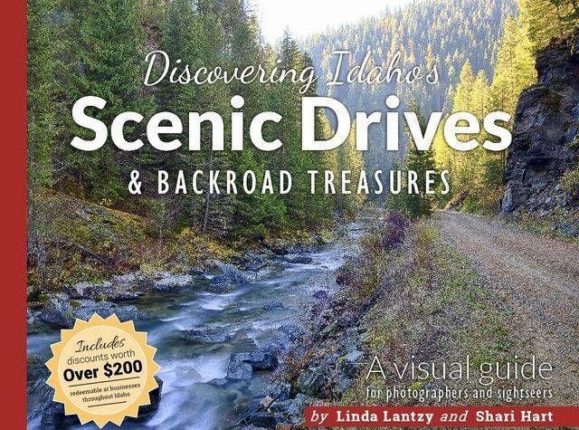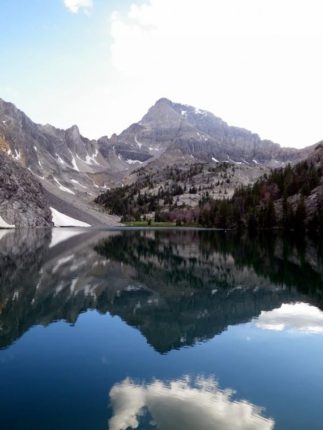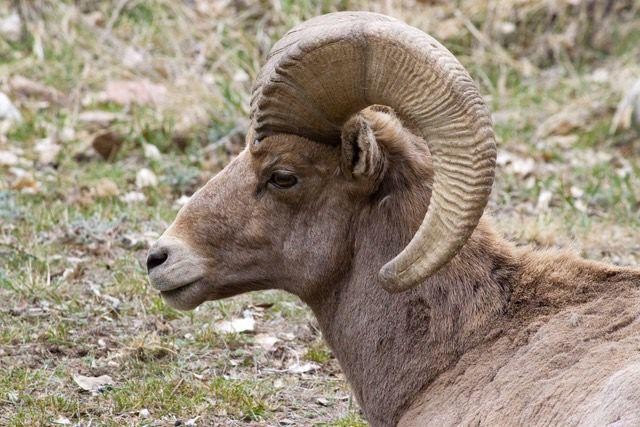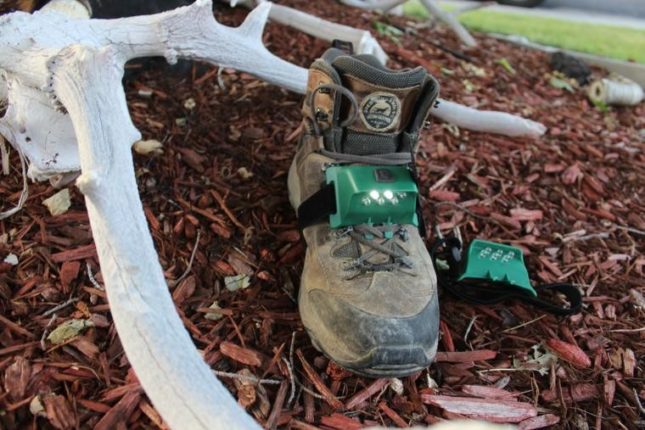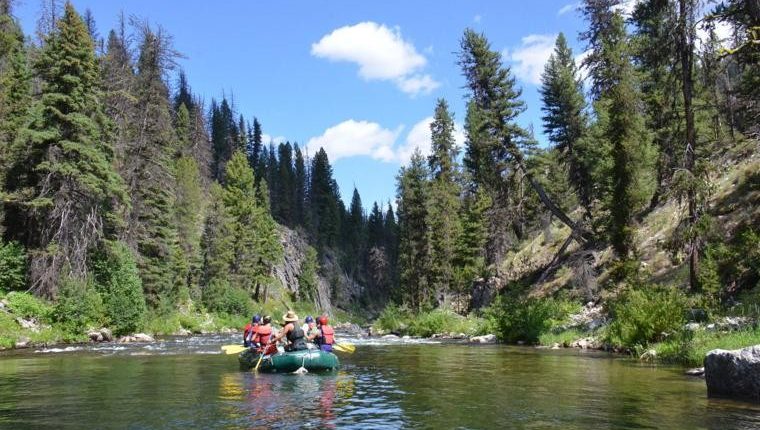Professional landscape photographer Linda Lantzy has just released a comprehensive guide to some of Idaho’s most beautiful and iconic landscapes.”Discovering Idaho’s Scenic Drives and Backroad Treasures” takes photographers, sightseers and history buff…
Category: Outdoors
How to fish Idaho’s alpine lakes: planning your trip length
Fishing alpine lakes is a great reason to strap on a backpack and hit the trail. There’s nothing quite like the experience of catching a trout in Idaho’s backcountry, but with more than 1,000 high mountain lakes that hold fish in Idaho, deciding on a destination can seem daunting. If you don’t know where to start, the Idaho Fishing Planner might help narrow your search. First, filter the list of waters for “high mountain lake,” which can be found at bit.ly/30b3Tpy, then add more filters like “Region” and the fish species to further narrow the list.
Before you lace up your hiking boots, a little pre-trip planning is in order. By asking yourself a couple of questions, you can whittle down your list of possible fishing spots:
- How many days do you have to spend in the backcountry?
- How far are you willing to hike? Know your abilities and hike accordingly. Keep elevation gain in mind, as altitude can make a big difference on the trail.
Once you’ve answered those questions, it’s helpful to split high mountain lake excursions into three categories: day trips, short multi-day trips and extended trips. Here is a basic breakdown for each and some things to consider:
Day trips
These are easiest in terms of logistics and planning. Since you eliminate much of the work involved in staying overnight, day trips are great for beginners looking to get started. Equipment needs for a day hike fishing trip are pretty simple: some basic tackle, a water bottle, water purifier, snacks, rain jacket and a daypack to carry everything. Invest in some comfortable hiking boots and your feet will thank you later.
For most people, expect to only cover 2 miles per hour on good trails and 1 mile per hour cross-country. To determine how much time you’ll have to fish, factor in the amount of time it takes you to access the lake and return home. Day hikes are almost always shorter, so your choice of lakes will likely be limited to those within a few miles of a road.
Although summer days are long, think about how much time you want to spend hiking and fishing to plan the length of the hike.
Lakes that lie off the trail usually see less pressure, but they can be challenging to access, especially through dense forest or over steep terrain.
In addition to standard fishing gear, day trips can be a good time to bring along a float tube or pack raft, since you are not carrying a lot of camping gear or multiple days of food. Taking a float tube to any backcountry lake can increase your chances of catching fish when they move away from shore.
Make sure to do your homework in terms of pre-trip planning. Check on trail conditions and access to the trailhead. While the hike might be short, carefully study the elevation gain. A 3-mile hike with moderate climb will be much easier at 6,000 feet than at 9,000 feet. This is where it is important to know your abilities and hike accordingly.
Short multi-day trips (two to four days)
Trips of two to four days are a great way to fish alpine lakes. They offer all the advantages (and fun) of spending a few nights in the woods. Such trips take a bit more planning, but the payoff is usually worth the extra effort.
A trip over several days allows you the option to hit multiple lakes, increasing your chance of finding good fishing. Having a few days also gives you the option to access places fewer anglers visit, generally making for a better backcountry experience and better fishing. Plan the number of days according to how much territory you want to explore, or the area of interest. Moving camp allows you to cover lots of ground and explore new areas each day. On the other hand, setting up a base camp and day-hiking to nearby lakes gives you more time to concentrate on fishing a specific area (or group of lakes) without hauling all your gear the whole time.
Multi-day trips give you the option of several trip formats. Besides the typical in-out along the same path, think about combining trails to form a loop back to your start point, or set up a vehicle shuttle to move your car to your exit point. While a multi-day trip gives you the opportunity to push further into the backcountry, it doesn’t mean you have to hike far. Some careful map reading can discover clusters of lakes with 3 to 6 miles that can easily fill a long weekend.
Extended trips (five-plus days)
Keep in mind that we’re just focusing on fishing trips here, not planning a six-week quest into the wilderness. With that in mind, anything beyond a long weekend counts as an extended trip.
These trips are not for beginners — or the faint of heart. The longer you are in the woods, the more likely you are to encounter challenges like bad weather, fatigue, hunger, injury or equipment failure. Extended trips offer great rewards, but the added time in the field presents very real logistical challenges and risks that you need to consider. The added food usually makes for a heavier pack, so be prepared for the extra load.
That said, extended trips can get you deep into the woods and provide a rich backcountry experience. Longer trips are great if you are looking to hit many lakes, catch a variety of species and see the most scenery.
With good trip planning and creativity, you can find ways to “lighten your load” on extended trips. Selecting a location for a food cache you can come back to every few days is one option, but be sure your cache is secure from wildlife, especially bears. Identifying what gear is necessary, versus additional “comforts” may also help you with packing light. However, dialing in your backcountry gear is typically something that comes from experience.
As a beginning backpacker, it’s recommended that you get several shorter trips under your belt before planning an extended trip. The consequences of mishaps are much more serious the farther you venture from civilization, so plan accordingly.
F&G seeks public comment on proposed sage-grouse hunting season
Idaho Fish and Game officials are asking hunters and other interested parties to review and comment on a proposed sage-grouse hunting season for 2019. Deadline to comment is Aug. 19.
Statewide, sage-grouse lek counts indicate a 25 percent decline in males at leks in spring 2019, compared to 2018. Data indicates that most sage grouse populations can be hunted at the “Restrictive” level, as defined in the 2006 Conservation Plan for the greater sage grouse in Idaho. However, Fish and Game data also calls for caution in some areas north of the Snake River and in part of Owyhee County.
2019 hunting season proposals include:
- The sage-grouse hunting season would open on Sept. 21 and 22 for the two-day season and Sept. 21 to 27 for the seven-day season.
- Close northwest Owyhee County, northwest of the Mud Flat Road (Area 1 in Owyhee County). Birds in this area were impacted by the 2015 Soda Fire. Part of this area was closed in 2018, but wildlife managers are proposing to expand the area in 2019 due to population declines outside the fire boundary.
- Restrictive seven-day season, one-bird daily limit, for the remainder of Owyhee County (southeast of the Mud Flat Road) and all areas south and west of Interstate 84 (Area 2).
- A two-day season, one-bird daily limit, for most areas north of the Snake River (Area 3). Fish and Game would maintain the closure in the Upper Snake region that was closed last year due to the Grassy Ridge Fire and other declines (Area 1 in eastern Idaho).
- Southeast Idaho would remain closed as it has since 2014 (Area 1).
To see a map of area proposals, comment and get more information see the 2019 Sage-Grouse Season Scoping Proposal or learn more about sage-grouse conservation and management.
Bighorn sheep lottery tag raised over $109,000 for sheep research and management
For the Arizona hunter whose ticket was pulled for the 28th annual Bighorn Sheep Tag Lottery, it represents the hunt of a lifetime. For Idaho Fish and Game, it means more than $109,000 in funding will benefit wild sheep conservation in Idaho.
The lucky winner of the 2019 Bighorn Sheep Tag Lottery was Andrew Tomlinson, a resident of Prescott, Arizona. The Idaho Wild Sheep Foundation held the drawing outside Fish and Game Headquarters in Boise on July 31. Tomlinson was one of around 1,000 people from across the nation who bought anywhere from one to several hundred chances. The winning ticket was drawn by Idaho Fish and Game Director Ed Schriever.
In 2019, the lottery raised over $109,000, the second-highest total ever, and the highest for a year in which the lottery tag cannot be used in Hunt Area 11 in Hell’s Canyon.
The lottery tag is offered under a partnership between Idaho Fish and Game and the Idaho Wild Sheep Foundation, which has been hosting the bighorn lottery since 1992, with the proceeds going back to Fish and Game for bighorn sheep conservation.
In the 28 years that the Idaho Wild Sheep Foundation has hosted the lottery, it has raised nearly $2 million. In recent years, the proceeds have helped Fish and Game with monitoring disease in bighorn sheep populations, preventing interaction between bighorn sheep and domestic sheep, and improving relationships between sportsmen and private landowners.
For more information, contact the Idaho WSF office at 208-345-6171 or visit www.idahowildsheep.org.
BLM to begin Goodenough Creek Campground renovations
POCATELLO — The Bureau of Land Management’s Pocatello Field Office (PFO) will renovate Goodenough Creek Campground between Sept. 3 and Dec. 2 to enhance recreational experiences for the public. The campground will be unavailable for use during this time period to ensure public safety.
“The purpose of improving the campground is to add more sites to accommodate larger recreational vehicles, install a toilet in the middle of the campground in proximity to the tent sites and improve the day use parking area to allow for more vehicles,” Assistant Field Manager Blaine Newman said. “The Pocatello Field Office is excited about making improvements to the campground to benefit the public recreating there.”
The PFO will be completing maintenance projects within the campground, including rebuilding the main access road and recreational vehicle turnaround, and expanding the day use parking area. Water diversion controls, additional campsites and a new toilet will also be installed.
While the campground is being renovated, the public can camp at other nearby campgrounds, including the PFO-managed Hawkins Reservoir Campground and non-BLM campgrounds. The trails adjacent to Goodenough Creek Campground that lead onto the Caribou-Targhee National Forest can be accessed by other trailheads located in the forest
The .270 Winchester lives up to its reputation
One of the biggest mistakes I made growing up was to not take a couple of my paychecks and buy a .270 Winchester rifle for hunting deer, elk and moose.Many of my friends had purchased .270 Winchesters, and I thought they were excellent rifles, but I ha…
Sage grouse numbers continue to drop in Idaho
BOISE, Idaho (AP) — Idaho’s sage-grouse numbers have dropped 52% since the federal government decided not to list the birds as an endangered species in the fall of 2015.
It’s not yet clear whether the three-year decline is part of a cyclical pattern or indicative of a more serious issue, but the Idaho Statesman reports the trend could force state and federal wildlife and land managers to take a closer look at how sage grouse are faring in Idaho and other western states.
Under Idaho’s sage grouse management plan, wildlife managers must work to determine the cause of population declines and come up with an appropriate response any time numbers drop below a certain level. Idaho Fish and Game biologist Ann Moser says it looks populations are low enough in several parts of Idaho to trigger the plan.
The U.S. Fish and Wildlife Services estimates that there are between 200,000 and 500,000 sage grouse, most of them in Idaho, Nevada, Wyoming, Montana, Oregon, Utah and Colorado.
First sockeye of 2019 arrives at Stanley; run likely to be lowest in more than a decade
The first sockeye of 2019 returned to the Redfish Lake Creek trap near Stanley on Aug. 2. The first sockeye arrived on July 26 last year, and July 27 in 2017.
The fish is among the 53 sockeye that have so far crossed Lower Granite Dam near Lewiston (through Aug. 1), which is the last dam the fish cross before reaching Idaho.
The 2019 sockeye run through Lower Granite so far is below last year’s total of 276 fish, as well as the 2017 total of 228 fish, which was the the lowest return in a decade. It is likely that the returns in 2019 will be lower.
Idaho sockeye must complete a 900-mile migration from the Pacific Ocean that includes crossing eight dams and climbing 6,500-feet elevation to reach the Sawtooth Basin.
When Idaho sockeye were listed in 1991 under the federal Endangered Species Act, only four adult sockeye returned to the Stanley Basin. The combined annual returns from 1991-99 was 23 fish, including two years when no sockeye returned to Idaho. Between 1996 and 2007, annual sockeye returns over Lower Granite averaged 52 fish. Since 2008, sockeye returns over Lower Granite have averaged 1,115 fish with an annual range of 228 to a high of 2,786 in 2014.
Sneaky hunters might like SneakyHunter Bootlamps
I recently met with Jim and Annette Manroe, the owners of SneakyHunter Bootlamps, and am excited about testing out their new “boot lamps.” They are a unique invention and believe it or not, they produce them in Nampa. So if you like supporting homegrown businesses, look no further.
As an outdoor writer, I get to test literally hundreds of products each year, and 99 percent of the new products are a slight variation or improvement of an already existing one. Not so with SneakyHunter Bootlamps. It is a new concept altogether.
Think of them as a headlamp for your feet. Why did I not think about that? Headlamps are great, but if you hear a bear while hiking down the trail you have to focus the light on the bear and hopefully not stumble over a rock or go off the side of a mountain when you shift the focus of the light off the trail. The Bootlamp will always be focused right on the trail in front of you.
But actually, the reason that Jim and Annette invented them was because he got tired of sneaking into his favorite hunting spot before daylight and spooking the elk and deer with his wildly swinging flashlight. If he hit them in the eyes or inadvertently swept over them, they spooked.
With the advent of SneakyHunter Bootlamps, you no longer have to worry about the above scenarios occurring. Especially since it has three sight settings. 1. White light for walking. 2. Red light for walking and, as we know, a red light doesn’t spook game. That is why we use red lenses when spot lighting. 3. The violet light is used to track. This light illuminates a blood trail better than the popular UV lights.
Operating/setting them up is easy. Both units operate off of three AAA batteries. I’d recommend putting the buckle on the outside of your foot. Your buckle is on the outside on your spurs isn’t it? But if you can’t bend over very good it may be easier for you to tighten them up if the buckle is on the inside. After deciding which route you go, you might even want to use a magic marker to write an “L” on one and an “R’ on the other one so in the future you know which foot to put it on in case you’re OCD and absolutely have to have the buckle on which side you consider proper position. Normal people will probably care less!
Adjust the placement so that the Velcro strap is under your instep. There are two prongs on the front of the unit. Slip these under the boot strings. The unit is made so that it is mounted in the proper position and the light will shine where it is needed.
While backpacking and flyfishing I love to hit the evening hatch. Which means that there is a good chance that I may be down the river a good ways hitting it at dark. I wear Chaco sandals for wading in and out of the water while fishing. But will they work on my Chacos? No problem-o. I just tested it and the prongs fit under the strap and holds tightly in place.
To turn on the unit, there is a button on top. One click turns on the white light, two clicks turns on the red light and three clicks turns on the violet light. But hold on, what about walking through grass in the morning damp with dew? It has a hard foam compression pad on the lid that while it doesn’t rate it as water proof, it does rate it as water resistant.
Katy and I are headed over this weekend to Colorado to fly fish, ride horses and hike at the Wild Skies Flat Tops Cabin in northwest Colorado. We got us a pair of SneakyHunter Bootlamps just in time! Bring on the adventures.
They also make Hiker Bootlamps. These are different in that they offer white, red and green lights. Many hikers face depth perception issues when using a light source above the waist. This problem is eliminated by the Bootlamps since the light source is low to the ground. It also prevents blinding approaching hikers since it won’t hit them in the eyes.
Tom Claycomb lives in Idaho and has outdoors columns in newspapers in Alaska, Idaho, Utah, Nevada, Colorado and Louisiana.
‘RUGGEDLY WILD’: Rafting and fishing the Middle Fork of the Salmon River
The wild and scenic Middle Fork of the Salmon River winds its way through the largest wilderness area in the Continental U.S.: the Frank Church Wilderness Area in central Idaho. It is vast, majestic and ruggedly wild. Thousand-foot-tall side canyons plunge into the river. Steep, rocky and forbidding, they form a unique wilderness rafting experience.
Getting an individual rafting permit for the Middle Fork of the Salmon River is like winning the lottery. Considered one of the gems of the rafting world, applications for the limited number of summer rafting permits pour in from throughout the U.S. There are lots of applicants but few winners.
So Geoff Hogander and I decided to enjoy the luxury of a rafting company, Middle Fork Wilderness Outfitters, with roots to our hometown of Pocatello.
Owner and Guide Willis McAleese Jr. is a Pocatello native who made us feel right at home. We love to fish, and this trip added the benefit of McAleese’s expert fishing experience. He has guided raft trips and anglers for two decades down East Idaho waters.
What more could you ask for? A hundred miles of wilderness river to float, over 100 rapids, pristine country, crystal clear water with cutthroat, rainbow and bull trout. And a guide that knows how to catch them.
Strapped into life jackets, we all got the safety lecture, were shown where to sit on the rafts, paddle and how to use the inflatable kayaks. Everyone gravitated to the kind of whitewater adventure they wanted. Most days, Geoff and I chose the big rafts and fished off the back. One day, I did the inflatable kayak. No fishing, lots of bobbing and staring at stacked up whitewater waves. Hmm, fishing seemed like a really good option.
Stops each day along the river featured hikes to waterfalls, hot springs for a soak and cliffs with pictographs to marvel at. Willis and his guides were excellent interpreters of the time and tribes that left their history on the rocks. It is a holistic type of experience looking down at the river from where ancient artists scribed their trade painting sheep, wolves and people. The majesty of what laid before the artist brings the paintings to life.
Photography
The photographic opportunities on the river are excellent and endless. During the six-day trip, we snapped photos as we drifted, cascaded over rapids and swirled in deep pools. Overhanging cliffs with vistas of shimmering water were common. Canyons contrasting with blue and green waters flanked by massive granite boulders added depth to the size of the wilderness area.
Most of the group used their phone cameras. Yes, phone cameras. The camera optics in the new iPhone and androids are exceptional. Our group snapped photos of bald eagles, waterfalls, pictographs, hots springs, fishing, moments of laughter, camps and all sorts of vivid plants and rock formations.
Dining outdoors
The first dinner on the river set the stage. Shrimp wrapped in bacon with libations of your choice were starters. Salmon cooked over the open fire on cedar planks and a fresh green salad was paired with pasta. I loved the salmon topped with huckleberries.
The last night, tri-tip roast glazed and barbecued over the open fire and paired with a giant Idaho potatoes and all the toppings capped off the trip. Geoff and I chose a fine glass of red wine to accompany our meal. The topper was a dutch oven chocolate cake with chocolate frosting for a guest’s birthday. To celebrate, some brought along funny costumes featuring walruses and a marlin! A fun group of new friends.
Breakfasts ranged from eggs benedict to hot cakes with real maple syrup. Lunches were served on tables set on sandy beaches with an array of sandwich makings and a pasta salad. Pineapple and other fruits finished off lunch with a cookie the size of a small plate.
Fishing the Middle Fork
The most stunning aspect of fishing the Middle Fork is the miles and miles of fishable water. We averaged about 20 miles a day and cast a thousand times into riffs, seams and eddies that made you expect a strike with each cast.
One of the fishermen was a ringer. Willis McAleese Sr. joined us, and he is an excellent fly fisherman. He and his son cut their teeth fishing the Snake River out of Pocatello and they are good. He teamed up with his son and provided us with flies that worked and tutored us on how to fish the cliff edges, side pools and flat water. Our talents varied and catches of cutthroat trout and rainbows ranged from double digits to me getting skunked an entire morning.
I am not a fly fishing purist. So when I was getting skunked I broke out my mini spinning gear and at times out fished everyone but Sr. Other times they waxed me.
The raft crew
The rafting crew was a delightful mix of young and middle-aged individuals who love the river life. Geoff took a shine to Lara Sagatov, a 27-year-old raft guide with experience rafting many of Idaho’s rivers. He nicknamed her the River Goddess. All of the crew took turns at most of the tasks on the rafts and lifted ice chests and baggage till our arms would have revolted.
Personal time to reflect
The solitude, vast canyons, rock ledges dropping into the river help one reflect on who and where you are. Few places offer the experience I had the last evening of the trip.
Walking up the river a quarter mile from camp, I was casting a thumb-sized lure for cutthroat trout enjoying the evening. My luck was good, and I caught two 12- to 14-inch cutthroat and released them. Then I hooked into one of the native bull trout weighing about 2 pounds. It cut through the darkening waters putting up a fine fight. I took a photo of it, released it and sat down.
Not 15 feet away, watching me was an adult river otter, head propped out of the water next to the bank. I did not move. Dodging its head back and forth, it stood up on its hind feet looking at me. Probably wondering what nut of a fisherman would let dinner go. A minute later, a smaller, sleeker otter rose out of the water to eye me. The bigger otter found its footing and stood up looking at me. With a slight sound from the smaller otter, they slipped underwater and were gone.
A wonderful conclusion to a spectacular trip that slipped away too quickly.
